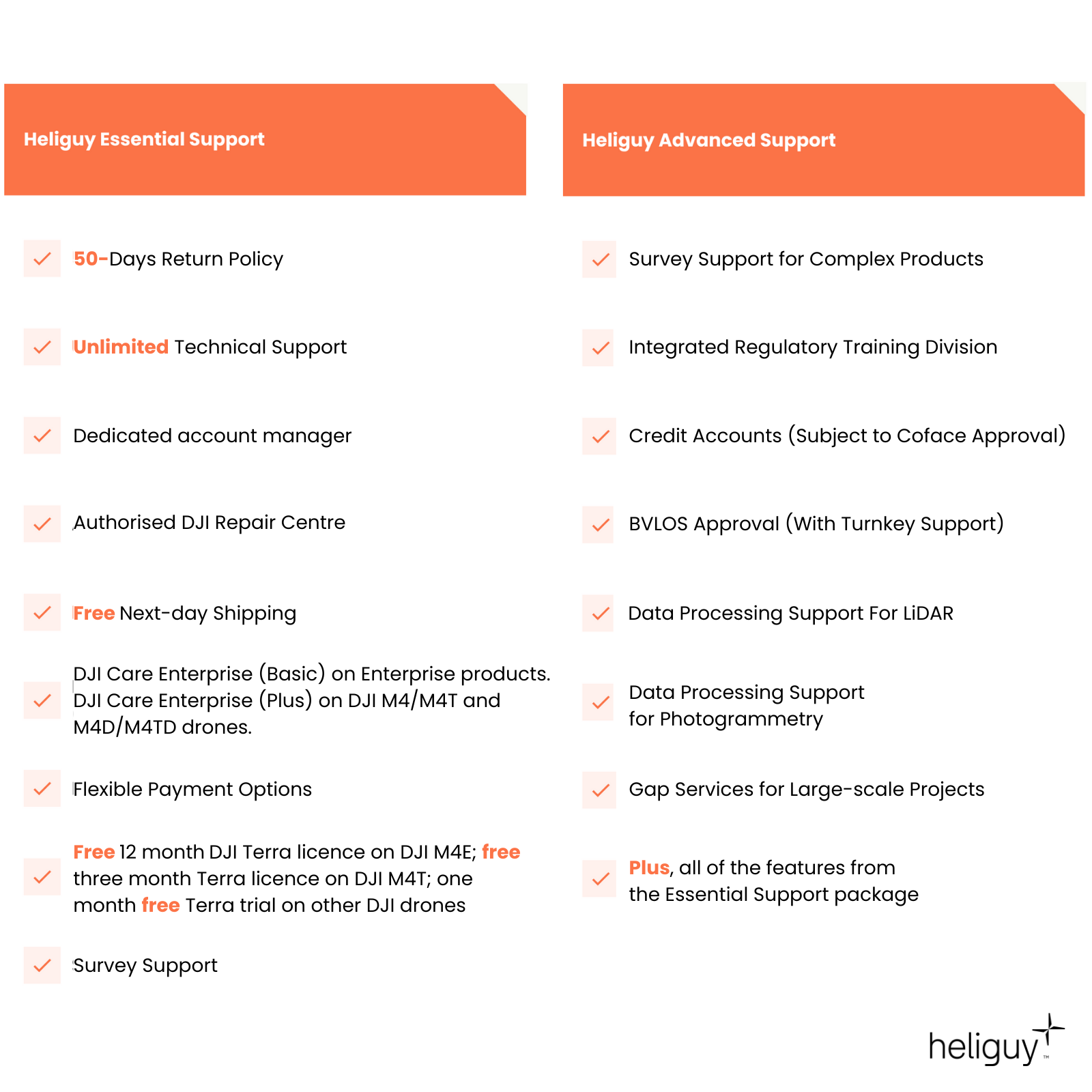DJI M300 RTK Drone Parachute
£0.00
Tax included in UK & Shipping calculated at checkout
50-days return policy
Next-day delivery - order before 3 pm
The DRS-M300 is an intelligent, lightweight parachute designed for the DJI M300 RTK, offering easy repacking and quick reuse. Developed by Drone Rescue Systems, it provides reliable autonomous protection and has been used globally by professionals and authorities.
Overview
Contents
Specifications
Support
FAQ
Heliguy Services
DRS-M300, Drone Parachute
Drone Parachute Benefits
Safety Measure: The drone parachute is designed to prevent injury and property damage in case of a malfunction or loss of control, ensuring a safe descent to the ground.
Crowded Area Protection: Provides added safety in crowded or densely populated areas by reducing the risk of harm to people and buildings during a crash.
Damage Reduction: Slows the drone's fall, minimizing severe damage and potentially saving on costly repairs or replacement, leading to reduced downtime.
Legal Liability Mitigation: Enhances safety by preventing property damage and personal injury, which helps mitigate the risk of expensive legal liabilities.
DRS-M300, Drone Parachute
Reliable Drone Parachute System
Reliable Safety Measure: Count on the DRS-M300 Drone Parachute to enhance the safety of your flights.
Optimised for DJI Matrice 300 RTK: The DRS-M300 is specifically designed for the DJI Matrice 300 RTK, integrating seamlessly via DJI’s onboard SDK and supporting all current DJI extensions and antennas.
Enhanced Failure Detection: Flight parameters for failure detection are customised for the M300, based on extensive flight data to optimise failure detection algorithms.
DRS-M300, Drone Parachute
Lightweight Design
Lightweight Design: The DRS-M300 parachute is engineered to be lightweight at 490 grams, significantly less than comparable systems that can exceed 900 grams.
Compact and Non-Intrusive: Its compact design minimizes interference with other payloads and reduces wind resistance, ensuring efficient operation.
Convenient Storage: Fits within the original DJI M300 RTK carrying case, eliminating the need for additional storage solutions in the field.

DRS-M300, Drone Parachute
Automatic Deployment & Flight Termination System
Automatic Problem Detection: The DRS-M300 parachute features intelligent algorithms, an independent IMU, and electronics to automatically detect issues and malfunctions, ensuring reliable and swift activation.
Manual and Automatic Activation: While manual triggering is available, automatic activation provides more reliability and faster response, particularly beneficial for BVLOS (Beyond Visual Line of Sight) operations.
Motor Shutdown for Safety: In the event of parachute ejection, the DRS-M300 immediately stops all motors to prevent entanglement of parachute lines and reduce the risk of harm to people on the ground during descent.

DRS-M300, Drone Parachute
Low-Altitude Deployment
Responsive Failure Detection: Integrates with Drone Rescue Systems' patented sling-chute ejection mechanism for rapid and powerful parachute deployment.
Quick Deployment: Ensures the parachute fully inflates within 9 to 14 metres of descent, depending on the drone's take-off weight, for effective emergency response.
Pressure-Free Storage: The parachute is stored without pressure to facilitate faster inflation and ensure safe landings, even at lower altitudes.

DRS - M300, Drone Parachute
Simple Installation & Reusability
Easy Installation: The DRS-M300 is a plug-and-play solution that installs in under 10 minutes without the need for soldering or advanced electronics knowledge.
Quick Reusability: After deployment, the system is ready for use again within minutes by simply repacking or using a spare parachute, with no expendable materials to replace.
Cost and Eco-Friendly: No obligation to purchase spare parachutes or return them for repacking, saving time and money while reducing environmental impact.

DRS-M300, Drone Parachute
Safe Handling
Safe and Easy Handling: The DRS-M300 does not use pyrotechnical components, heavy metal springs, or gas cartridges, making it easy and safe to handle.
Travel-Friendly: Without hazardous pyrotechnical propellants, the system avoids restrictions on travel and shipment and eliminates the need for replacements after each activation.

DRS-M300, Drone Parachute
No Extra Battery Needed
No External Battery Required: The DRS-M300 operates using the drone's power supply, eliminating the need for a separate battery that requires frequent charging or replacement.
Power Loss Protection: Even in the event of a full drone power loss, the system can still deploy the parachute, ensuring safety.
Minimal Power Consumption: With continuous power consumption at just 0.6W, the DRS-M300 has a negligible impact on flight time.

DRS M300, Drone Parachute
Real-Time Updates & Blackbox Storage
Pre-Flight Status Updates: Audible and visual indicators confirm the system's readiness before takeoff, alerting the pilot if any issues need attention. The LED colour code provides clear diagnostics, with troubleshooting guidance available in the detailed user manual.
Post-Deployment Warning Signal: After parachute deployment, a loud warning signal alerts people on the ground to the descending drone, enhancing safety and preventing accidents.
Continuous Flight Data Logging: The system continuously stores flight data on an internal SD card, allowing for post-incident analysis to identify the cause and prevent future occurrences.

DRS M300, Drone Parachute
Quick-Release and Geofenching Features
Quick-Release Bayonet Lock: The DRS features a bayonet lock mechanism that allows the parachute container to be quickly removed while leaving installation components like wires and lining on the drone. This is convenient for storage or missions where the parachute isn't required.
Geofencing Safety Feature: The DRS-M300 includes a geofencing option that prevents the drone from leaving a predefined geospatial area. If the UAV violates this boundary, the parachute will automatically deploy, enhancing safety and compliance with JARUS's SORA guidelines.

Accreditation
![UK CAA Recognised Assessment Entity (RAE)]()
UK CAA Recognised Assessment Entity (RAE)
Authorised GVC/A2 CofC Training Courses
![UK CAA Permission for BVLOS Flights: Operational Authorisation UAS 15435]()
UK CAA Permission for BVLOS Flights: Operational Authorisation UAS 15435
Helping companies unlock BVLOS missions in an AAE with DJI Docks
![The UK's only DJI Gold and S-Level Partner]()
The UK's only DJI Gold and S-Level Partner
Trusted supply on DJI products
![ISO 9001 Certification]()
ISO 9001 Certification
Driving industry standards through robust operational protocols for enhanced safety and reliability
![Training Qualifications UK]()
Training Qualifications UK
Accredited training courses endorsed by TQUK.
![Ofqual-regulated Training]()
Ofqual-regulated Training
Recognised quality mark for meeting accreditation criteria.
![Cyber Essentials]()
Cyber Essentials
Verified data security
![Financial Conduct Authority]()
Financial Conduct Authority
Authorised to conduct regulated financial services
![Armed Forces Covenant Defence Employer Recognition Scheme - Silver Award]()
Armed Forces Covenant Defence Employer Recognition Scheme - Silver Award
Proud supporter of our Armed Forces
![D-U-N-S Registered: 77-916-1210]()
D-U-N-S Registered: 77-916-1210
Verified to conduct international business









